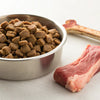Why Is My Dog Refusing to Eat Dry Food? Understanding Your Pet's Eating Habits
- Houndsy
Table of Contents
- Introduction
- Understanding the Basics of Dog Nutrition
- Common Reasons for Refusal to Eat Dry Food
- What to Do When Your Dog Refuses Dry Food
- When to Worry
- Conclusion
Introduction
Did you know that approximately 30% of dog owners report their pets refusing food at some point? If you’re one of those pet parents, you understand how alarming this can be. The sight of your furry friend turning away from their favorite kibble can evoke a wave of worry and confusion. Are they experiencing health issues, or have they simply grown tired of their food?
In this blog post, we will dive into the various reasons why dogs may refuse to eat dry food, ranging from health-related issues to behavioral quirks. We’ll also provide actionable tips to help you navigate this frustrating situation. By the end of this article, you will have a comprehensive understanding of your dog's eating habits and how to encourage them to enjoy their meals again.
As we explore the topic, we invite you to reflect on your own dog’s feeding routine. Have you noticed any changes in their appetite? Are there specific patterns or behaviors that could offer clues?
Let’s embark on this journey together to uncover the answers to the pressing question: why is my dog refusing to eat dry food?
Understanding the Basics of Dog Nutrition
Before we delve into the reasons behind your dog's refusal to eat dry food, it’s essential to understand the basics of canine nutrition. Dogs require a balanced diet that includes proteins, carbohydrates, fats, vitamins, and minerals to thrive. Dry food, commonly known as kibble, is designed to provide these nutrients in a convenient form. However, the quality of kibble can vary significantly based on the brand, formulation, and ingredients used.
The Role of Kibble in a Dog's Diet
Kibble serves several purposes:
- Convenience: Easy to store and serve, making it a popular choice for many dog owners.
- Nutritional Balance: High-quality kibble is formulated to meet the nutritional needs of dogs at different life stages.
- Dental Health: Crunching on kibble can help reduce plaque and tartar buildup.
However, not all kibble is created equal. Some brands may use fillers, artificial preservatives, and low-quality ingredients that can make the food less appealing. This discrepancy can lead to dogs turning their noses up at their meals.
Common Reasons for Refusal to Eat Dry Food
When your dog refuses to eat dry food, it can stem from various factors. Below, we outline the most prevalent reasons, both medical and non-medical, that may contribute to this behavior.
1. Medical Issues
Dental Problems
One of the most common reasons for a dog's refusal to eat is dental pain. If your dog has gum disease, broken teeth, or other oral health issues, they may find it painful to chew dry kibble. Signs to watch for include drooling, pawing at the mouth, and reluctance to chew.
Gastrointestinal Upsets
Dogs can experience stomach issues due to various reasons, such as dietary indiscretion or infections. If your dog seems nauseous, lethargic, or has experienced changes in bowel movements, they may be avoiding food due to discomfort.
Illness
Serious health conditions, including pancreatitis, kidney disease, or infections, can lead to a loss of appetite. If your dog suddenly stops eating and shows other concerning symptoms, such as vomiting or diarrhea, it’s crucial to consult your veterinarian.
2. Behavioral Reasons
Picky Eating
Some dogs can be quite picky about their food. If they’ve been spoiled with treats or table scraps, they may refuse to eat their dry food in hopes of receiving something more appealing. This behavior can lead to a cycle of finicky eating.
Stress and Anxiety
Dogs are sensitive creatures and can experience anxiety due to changes in their environment, such as moving to a new home, the arrival of a new family member, or loud noises. Stress can affect appetite, causing some dogs to refuse food altogether.
Kibble Fatigue
Just like humans, dogs can get bored with their food. If you’ve been feeding them the same kibble for an extended period, they might simply be tired of it. Offering variety can help keep mealtime exciting.
3. Environmental Factors
Bowl Issues
The type of bowl you use can also impact your dog’s willingness to eat. If their bowl is too small, slippery, or unclean, they may avoid eating. Additionally, bowls made of certain materials may retain unpleasant odors that could deter your dog.
Feeding Routine
Dogs thrive on routine. If there have been changes to their feeding schedule or environment—like a new location for their food bowl—they may become hesitant to eat. It’s essential to maintain consistency in their feeding habits.
What to Do When Your Dog Refuses Dry Food
Now that we’ve explored the potential reasons behind your dog’s refusal to eat dry food, let’s discuss actionable steps you can take to encourage them to eat again.
1. Consult Your Veterinarian
If your dog suddenly stops eating, especially if accompanied by other symptoms, it’s crucial to consult your veterinarian. They can rule out underlying health issues and provide tailored advice based on your dog’s condition.
2. Evaluate the Food Quality
Check the kibble’s expiration date and storage conditions. If your dog’s food has gone stale or smells off, it may be unappetizing. Consider switching to a higher-quality kibble that uses wholesome ingredients and avoids fillers.
3. Make Meals More Appealing
If your dog is simply bored with their food, you can try several strategies to make mealtime more enticing:
- Add Toppers: Incorporate healthy toppers like plain yogurt, pumpkin puree, or bone broth to enhance flavor and nutrition.
- Mix in Wet Food: Combining dry kibble with wet food can create a more palatable and aromatic meal.
- Warm It Up: Heating the food slightly can release aromas that may attract your dog.
4. Change Feeding Routines
If your dog is sensitive to changes in their environment, try to maintain a consistent feeding schedule. Feed them in a quiet, familiar location to help them feel more comfortable.
5. Experiment with Different Bowls
If you suspect your dog dislikes their bowl, consider trying different types. Stainless steel bowls are easy to clean and less likely to retain odors, while elevated bowls can be more comfortable for older dogs with joint issues.
6. Encouraging Hydration
Sometimes, hydration can impact a dog’s appetite. Ensure your dog has access to fresh water at all times. You might encourage them to drink more by adding water to their kibble or offering ice cubes.
When to Worry
While occasional changes in appetite can be normal, certain situations warrant immediate attention. If your dog refuses to eat for more than 24 hours, shows signs of distress, or exhibits any concerning symptoms, it’s crucial to seek veterinary advice.
Conclusion
Understanding why your dog is refusing to eat dry food is essential for their overall well-being. By considering both medical and behavioral factors, you can create a supportive environment that encourages healthy eating habits. Remember to consult your veterinarian if you have any concerns, and don’t hesitate to explore different feeding options to find what works best for your furry friend.
As we strive to elevate the dog-feeding experience, we invite you to check out the Houndsy Kibble Dispenser. Our innovative design not only simplifies portion control but also complements your home decor, ensuring mealtime is both convenient and beautiful.
FAQ
Q: What should I do if my dog stops eating suddenly?
A: If your dog stops eating suddenly, especially if accompanied by other symptoms, consult your veterinarian to rule out any health issues.
Q: Can I switch dog foods abruptly?
A: It's best to transition gradually to a new food over several days to prevent digestive upset.
Q: How can I make my dog's dry food more appealing?
A: You can add toppers, mix in wet food, or warm the food slightly to enhance its flavor and aroma.
Q: What types of toppers are safe for dogs?
A: Safe toppers include plain yogurt, pumpkin puree, bone broth, and cooked vegetables. Always check for food sensitivities before trying new ingredients.
Q: When should I contact my vet about my dog's appetite?
A: Contact your vet if your dog refuses to eat for more than 24 hours, shows signs of distress, or exhibits any concerning symptoms.












